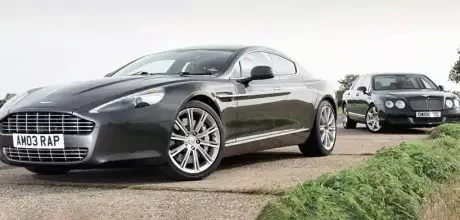Aston Martin Rapide vs. Bentley Flying Spur
Although undeniably good-looking and very fast, is the Aston Martin Rapide also spacious and luxurious enough to compete with the epitome of sumptuousness, a Bentley Flying Spur?
WORDS & PHOTOGRAPHY PAUL WALTON
RAPIDE vs FLYING SPUR
We pitch Aston’s latest four-door sports saloon, the Rapide, against one of its main rivals, the ultra-luxurious Bentley Flying Spur
On first glance, the Aston Martin Rapide and Bentley Flying Spur have so much in common that they could be twins. Both are luxurious four-seat saloons produced by established British car manufacturers, powered by huge 6.0-litre V12s and based on chassis used by earlier sports cars. And with them now worth between £25k and £35k, even their values are the same. But with one putting luxury first and the other being arguably more about performance, they’re actually as different as haute cuisine is from fast food. So which of these two very different cars do we prefer?
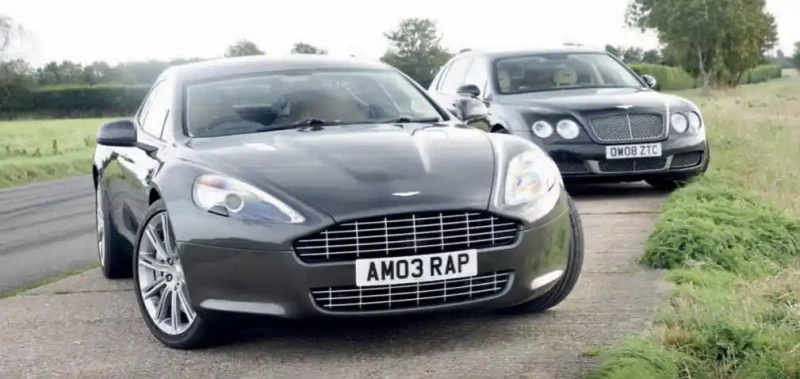
“Luxury must be comfortable,” said the French fashion designer Coco Chanel once, “otherwise it is not luxury.” If this is true – and she would know – it makes the Flying Spur one of the most luxurious cars ever produced. With generous levels of legroom and large seats covered in soft, supple leather, it offers high levels of comfort that the brand has long been synonymous with.
Yet when the car arrived in 2005 it was a new, more modern kind of Bentley. Instead of a bespoke chassis like the earlier albeit Rolls-Royce-based models, the Flying Spur used the same platform as the Volkswagen Phaeton, the German giant having bought Bentley in 1998. Due to a lack of capacity at Bentley’s Crewe factory, the first 1,400 examples were even produced at VW’s Dresden plant. It also shared 60 percent of its componentry with the Continental GT coupe that had arrived two years earlier, including the same VW-sourced platform. What wasn’t new, though, was its name.
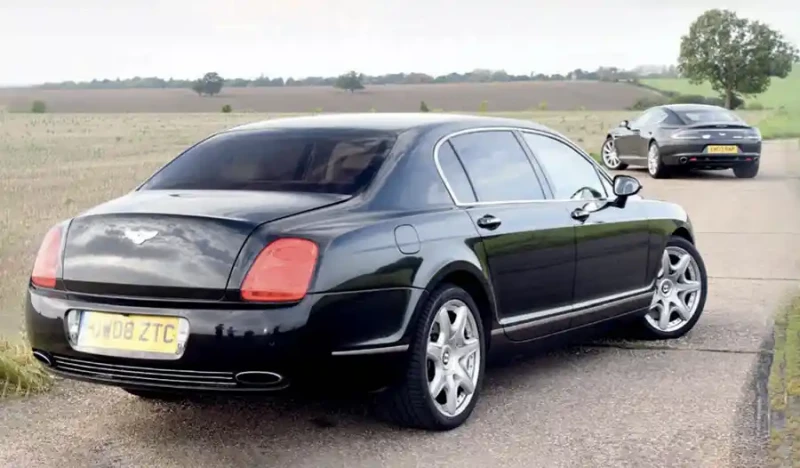
Flying Spur was first used for the S2 Continental of 1959 and then the faster version Rolls Royce Silver Spur III from 1994, its 2005 rebirth instantly linking the modern car to those of the company’s past. Led by Bentley’s head of exterior design, Raul Pires, under design director Dirk van Braeckel, the saloon and coupe were designed concurrently meaning they appear almost identical from the front. As with the Continental GT coupe, the faired-in grille and recessed headlights made the design very modern compared to the company’s more traditional models. It wasn’t always universally liked, though. “Like the GT, the Spur lacks the defiantly bluff stance and attractive caddishness of the Arnage,” said Evo magazine in its March 2005 issue.
Personally, I’m not a fan of the design thinking it’s too ordinary for a Bentley, the rear three quarters looking like a cross between the first generation of Škoda Superb (which Pires also designed) and a London taxi. Yet by towering over the much more feminine Rapide sat alongside it, its size together with that huge mesh grille gives the Flying Spur genuine presence.

As mentioned earlier, the Bentley is the epitome of luxury, the cream leather upholstery so soft that it feels like an expensive flying jacket, while the chrome and aluminium accents give an otherwise ordinary-looking dash some of the theatrics you’d expect from the brand. But there’s also too much cheap plastic for a Bentley, making the car feel mass-produced compared to its handmade predecessors.
Although this car has a traditional rear bench, the Spur was also available with two individual seats, similar to what the Rapide was given as standard. Other than the generous levels of legroom that allows me to stretch out like HM King Charles III no doubt can in the Bentley State Limousine, it feels surprisingly ordinary back there. But the company always reckoned it was a car to appeal to self-drivers rather than chauffeured types, hence the lack of ambience.
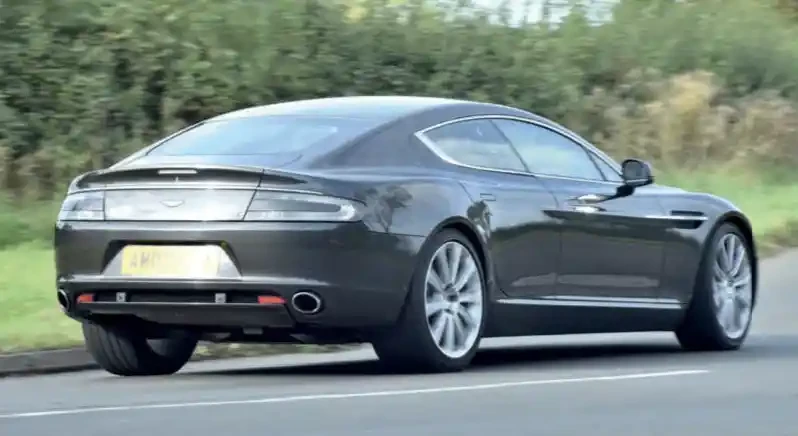
The poor way it has worn is disappointing with too many frayed edges and tired-looking leather for a car that when new in 2008 cost £117,500. Admittedly, this example is 15 years old and has covered 145k miles, but Bentleys were traditionally built to last.
There’s nothing wrong with the engine, though. The same 6.0-litre W12 as found in the Conti, it’s basically two narrow-angle V6 engines joined together at an inclined angle of 72 degrees. With twin turbochargers, it produces an incredible 552bhp and 480lb ft of torque, the resultant 0-60mph time of 4.9 secs and 195mph top speed made the Flying Spur the fastest saloon in the world at the time.

Considering this goliath of a car tips the scales at 2,475kg, that’s an impressive feat. “The acceleration barely diminishes,” continued Evo after driving the car in Italy for its 2005 press launch, “and by the end of a two-mile stretch of motorway, the speedo needle had reached 300kph (186mph) with plenty more to come.”
It might weigh the same as a small bus, but with the Flying Spur having permanent four-wheel drive plus adaptive air suspension as standard, it always feels surprisingly composed and confident. When I push hard through a corner, front and rear grip is phenomenal, while it might be slow and overly assisted but the steering is still relatively direct. Yet despite its AWD and even when the air suspension is set to firm, the Spur can never disguise its bulk and driving it quickly becomes more stressful than wrestling a bear.

No, the Spur’s natural habitat is wafting effortlessly down long European motorways to your European residence rather than hooning along B-roads, that same air suspension now easily digesting any road roughage. Yet when I bury the throttle, the six-speed transmission immediately kicks down resulting in a sudden and hard shove. But it’s never a refined unit, sounding loud under power which together with the traditional interior and weight makes the car feel relatively old-fashioned compared to the more contemporary Rapide. Thanks to its immeasurable luxury and power, the Bentley Flying Spur is a likeable car but it’s not a perfect one. Its size, weight and design give it all the subtlety of a sledgehammer.
Judging by this 2010 Quantum Silver example, it’s not something I can say about the Aston Martin Rapide. Long, low and very sleek, it’s more like a sharp scalpel than a blunt, heavy tool. As with the Bentley, the Rapide shares much with a two-door coupe, this time the DB9, sitting on the same VH bonded-aluminium platform that was also used for the V8 Vantage and DBS V12. Arriving in 2010 as a four-door saloon, the Rapide was the final model of a new family of cars that had been instigated by Aston’s then chairman, Dr Ulrich Bez.
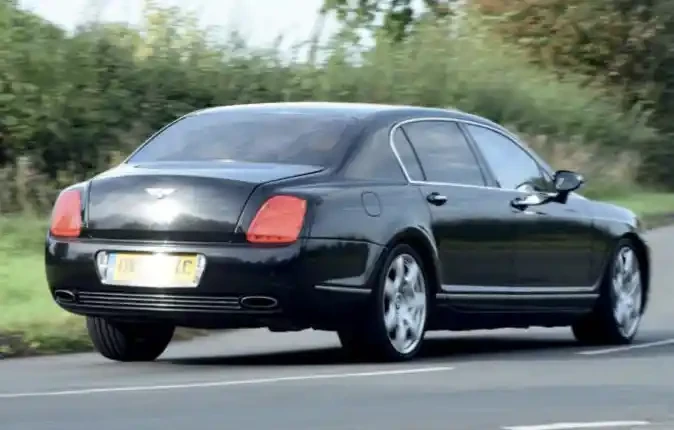
“With Rapide, the entire family can enjoy their Aston Martin together in unison,” he explained before the production car’s debut at the 2010 Frankfurt Motor Show, “in an invigorating yet comfortable environment, sitting low, with plenty of visibility from every seat and with new levels of comfort, refinement and entertainment.”
Again, like the Bentley, the Rapide name was an old one, originally used for the beautiful but low volume DB4-based Lagonda saloon of 1961. The 2010 version was also the first production four-door that Aston Martin had made since before the war.
Although designed under Aston’s current chief creative officer, Marek Reichman, it was clearly influenced by the earlier Ian Callum and Henrik Fisker-designed models; as with the Bentleys, see one from the front and it’s tricky to distinguish the Rapide from the DB9 or V8 Vantage. Only the different-shaped lower air vents set the trio apart for the casual observer.
Yet it’s still a handsome and elegant car, more so than the cumbersome Bentley and despite being an elongated coupe, it has close-to-perfect proportions. “We wanted to make the most beautiful four-door sports car in the world,” said Reichman when the concept was first shown at the 2006 Detroit Motor Show.
It might be almost two decades old, but I reckon they achieved that. There’s no denying its coupe-like shape results in a lack of interior space, though. Despite being 5,019mm long (309mm more than the DB9 but 271mm shorter than the gargantuan Flying Spur), I can’t stretch out in the same luxurious way as I can in the Bentley. Plus, with the front seats being very tall and wide, my view is heavily restricted meaning the rear could become very claustrophobic. This would be made much worse if the upholstery was black, like most examples are, and not the lighter Sandstorm of this example. But despite its low roofline, headroom is still surprisingly generous; admittedly at 5ft 10in I’m not a giant but I still fit inside reasonably comfortably. Due to the two individual seats rather than an oldfashioned bench plus a pair of cupholders and controls for the air-conditioning set in the wide centre console, the Rapide’s rear is a very special place. Its character is more like that of a private jet that I once flew in than a simple four-door saloon. Actually, the Rapide is technically a hatchback, the short luggage area giving access to the interior. Although at 317 litres (158 less than the Spur’s) the boot is small for such a large car, but the rear seats can be folded forwards. Although there’s no denying this aids its practicality, but it’s still not a car you’d want to take to Ikea. The Rapide eschews the traditional trappings of British luxury saloons so you won’t find any veneer across the dash. Instead, it’s the same soft-sheen ambience of the DB9 and V8 Vantage. All very modern, but the cheap-looking plastic controls and grey fascia perhaps lack the glitz and glamour of the Bentley especially considering in 2010 it cost £139,950, an incredible 12 grand more than the Spur cost at the time.

So it should come as no surprise that although the controls feel cheap, the fit and finish of the dashboard’s architecture has all the precision of the Austrian railway timetable. But there is a reason for this. As with the Spur, due to Aston Martin’s Gaydon factory not being able to keep up with demand for the existing models, for the first couple of years of its production the Rapide was also built overseas, this time by the Graz-based contract manufacturer Magna Steyr. Power comes courtesy of Aston Martin’s always magnificent 6.0-litre V12 that pumps out the same 470bhp as that in the DB9.
Mated to a six-speed automatic gearbox (there was never a manual option), it results in a 0-60mph time of 4.7 seconds and a 188mph top speed, both similar to its coupe counterpart.
These figures, though, only tell half the story; they don’t describe the responsiveness of the engine, how when I squeeze the throttle on an empty road, the V12 unleashes all of its power in one almighty fury resulting in a hard and sudden acceleration, especially when I use the steering column-mounted paddles. The V12 answers the moment I ask for more power by pulling on the lefthand lever to change down. The action sends the rev-counter needle dancing to the far right of the dial, ready for me to squeeze the throttle again.
The Rapide might have four doors and weigh close to 2,000kg, but it still feels every inch the sports car. With its chassis and panels both manufactured from aluminium, it offers all the agility of its smaller siblings. The steering has the same accuracy as the V8 Vantage with small movements on the wheel resulting in fast changes of direction yet the nicely damped suspension keeps everything perfectly composed.
It also rides beautifully, offering almost Jaguar saloon levels of comfort with uneven road surfaces not transmitted into the cabin. Unlike traditional sports cars, the Rapide doesn’t need to be driven like a hooligan to get the best from it.
As Car magazine said in 2010, “The Rapide certainly lives up to its sports car billing. However, it’s how the Rapide makes you feel when you’re just bumbling around town that makes it really special.” If you’re looking for a luxury limousine for airport chauffeuring duties (like the car featured here once was, hence the high mileage) then it has to be the Bentley.
The Aston might be comfortable but it lacks the Spur’s opulent levels of space, wall-to-wall leather upholstery and generous luggage compartment. But while the Bentley is also very fast, it’s an otherwise standard saloon. The Aston Martin by comparison has the ability to be much more; it can be a reasonably sensible family four-door hatchback one moment and a powerful sports car the next yet the ride quality remains as good as any properly luxurious limo. It’s also better-looking: the Bentley might look like the Škoda Superb, but the Rapide has the same razor-sharp design as Aston’s coupes. From being V12-engined four-door saloons to their luxurious interiors, there might be many ways in which these two cars are similar. But it’s their very different personalities and image that stops them from being twins and this is what puts the Aston Martin ahead.
Thanks to: Rapide owner, Aaron Muir, plus Nigel Britten from Area 5 of the Aston Martin Owners Club (amoc.org)


